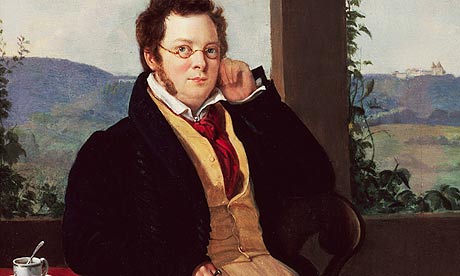
A small illustration of Schubert's genius: this week at the Wigmore Hall, the Artemis Quartet from Berlin (the first time I'd heard these players - they're astonishing, and worthy winners of a Gramophone award this year) played an early quartet in G minor that he wrote when he was 18, and his last and most ambitious string quartet, the one in G major, D887.
No composer investigated the ambivalence of major and minor modes more than Schubert, and nowhere more profoundly than in the G major quartet. The whole work questions the idea of "G major": in the opening two bars, the music slides from major to minor; the two inner movements are both in minor keys; and the tune in the final movement slips from minor to major, reversing the gesture of the first movement. This all means that the music is in a perpetual state of chameleon-like volatility. Schubert pulls the rug away from you all the time in this piece, like a tonal rollercoaster. The miracle is how he's able to create such a huge, 50-minute structure that is both architecturally convincing in its big picture and continually unstable in the miniatures of phrase and gesture. No other composer did this in the early 19th century.
But there were some fascinating clues prefiguring this in the earlier quartet: in the first movement of the G minor piece, D173, Schubert does the usual thing for a classical quartet in the first section, with a tune in the minor key and a second theme in the major. But when it's repeated, the first melody comes back in the major, and the second in the minor. What you get, effectively, is an arch form - minor-major, major-minor - which rewrites the rules of classical first-movement form. I can't think of many other minor-key pieces that do that - in his late teens, Schubert was already playing with the signs and structures of classical music.
Jörg Widmann, who is in his mid-30s, does it too: the Artemis played his second quartet, the Choralquartett, in between these Schubert masterpieces. The more I hear of Widmann's music, the more impressed I am. The single slow movement of the Choralquartett was just as dialectical as the Schubert, turning noise-sounds into music – the viola player made a violent cracking with the bow on the back of his instrument that sounded like the instrument splitting in two. His music also makes the supposedly conventional sounds of harmonies and melodies sound like alien interlopers. Inspired by Haydn's Seven Last Words from the Cross (a late suite of meditative slow movements for string quartet) and images of the crucifixion, the Choralquartett was at once deeply connected to other traditions and yet uniquely in its own expressive world. The Artemis Quartet plays Widmann's Third, Fourth and Fifth Quartets in the New Year at the Wigmore Hall - I can't wait.







